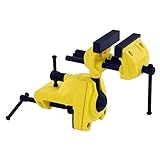If you sharpen your garden shears properly, you’ll get more use out of them, plus they’ll do a better job of cutting. That’s good for your arms as well as your plants.
Over the years, we’ve sharpened many a pair of garden shears for ourselves and for family and friends. We’d like to think we’ve learned what works best and what’s best avoided.

As well as telling you how to sharpen garden shears, we’ll also give you some tips about keeping them in good condition, including how to store them properly. Everything we tell you here will also work for other bladed pruning tools such as secateurs.
How to clean garden shears
Your garden shears must be clean before you sharpen them. This is because surface dirt reduces the effectiveness of the sharpening tool. It’s advisable to clean garden shears after every use. This is because surface dirt can make the blade less effective and can also make it harder for you to see (and deal with) minor damage before it becomes serious.
The easiest and safest way to clean garden shears is to use plain cold water either running or in a container, whatever’s convenient, plus a nail brush. Using a nail brush allows you to apply a decent bit of pressure without risking cut hands. We’d actually suggest investing in a decent nail brush for the job. Our favourite is this one, which is also great for hands.
Some people advise leaving garden tools to air dry after cleaning. This is certainly an option but we’re not big fans of it. Firstly, it’s the slowest so it gives rust the longest time to take hold. Secondly, you have to leave the blades open and we’re definitely not big fans of that.
You can dry the blades with a regular old cloth. Ideally, you’ll use one which is big enough to be folded into a pad so there’s a bit of space between the blade and your hands (but still be careful).
Our favourite trick, however, is to use a cheap bath sponge. These are thick but easy to grip and really absorbent, so they get the water off very quickly. Then you just wring them out, maybe leave them to air dry for a bit, and put them away for next time.
How to remove rust from garden shears
The easiest way to remove rust from garden shears is to use plain steel wool. That’s the sort without any cleaning agents. Most of the time the rust will come off easily with a bit of buffing. If not, try adding some WD-40 (or similar product) and waiting a bit before trying again.
How to stop garden shears from rusting
You can minimize (and maybe even prevent) rust on your garden shears by popping on some WD-40 (or plain oil) once a week or so. Of course, your garden shears will need to be clean for this.

The equipment you need to sharpen garden shears
First of all, you’ll need a good pair of gloves. If you have thorn-proof gardening gloves, they are generally your best choice as you can feel what you’re doing but still have a decent level of protection against cuts.
You also need safety goggles. It’s not worth risking your eyesight with metal shards flying about the place. All it takes is for one to hit you and you could lose your sight permanently.
If you’re using an angle grinder to sharpen your garden shears then it’s also advisable to use a mask. If you don’t have one, you can improvise with a scarf or bandana to cover your nose and mouth.
In principle, you can sharpen garden shears with an angle grinder or a bench grinder. In practice, even if you have these, they can be quite difficult to use as they move quickly and give off sparks.
We’d suggest sticking with a hand file and a sharpening stone. Assuming you sharpen your garden shears fairly regularly (i.e. before the blades get really blunt), then your main tool will be a hand file. Then you can use a whetstone to finish off the job (if necessary).
We’d also suggest investing in a vice. This isn’t essential, but it does add a whole lot of safety and convenience for very little money, space and weight. Also, once you have one, you’ll probably find yourself using it for all kinds of purposes.
How to sharpen garden shears
As previously mentioned your garden shears need to be clean and free of rust before you start sharpening them. It’s best if you can hold your garden shears in a vice. If you don’t have one, see if you can improvise a way to hold your garden shears in place so you keep your hands free. This is safer and allows you to work with your whole body weight.
You need to have one of the bevelled edges upwards. The bevelled edges are the parts of the blades which do the actual cutting. You can recognize them by the fact that they’re angled. This is the part you need to sharpen. Sharpening the flat part of the blade is just a waste of time and energy.

Work from the handle to the tip and keep the file straight. You want to go forwards and backwards in long, smooth strokes. Ideally, you want to cover the whole blade in one stroke. Apply medium pressure and keep sideways movement to an absolute minimum. Essentially, the idea is to follow the angle which is already there and just make it sharper.
Check every couple of strokes and see if the blade has the same shine from handle to tip. If it does, great, if it doesn’t you’re not holding the file at the right angle. Adjust it and try again.
Once you have a sharp edge on your blade, (usually in about 20 or 30 passes), use a finer file and/or whetstone to finesse this so your blade ends up as sharp as you want it to be. Then repeat the exercise on the other blade.
How to sharpen secateurs
For completeness, if you’re sharpening smaller pruning tools, like secateurs, then you may need to use a circular motion rather than long, smooth strokes. In principle, you can use a file for this, but in practice, a whetstone is usually by far the easier option.

How to remove burrs from garden shears
In metalwork, a burr is basically a rough edge raised by the action of sharpening. If you have done your filing properly, you should see burrs as this is an indication that you have made the blade as sharp as it can possibly be.
Once you have finished sharpening your garden shears, however, you will need to remove the burrs. A few strokes with the file or whetstone should achieve this. Just remember to keep the pressure light or you will transfer the burr to the bevelled edge you have just sharpened.
How to maintain garden shears
Sharpening your garden shears is a good opportunity to give them a general check-over. While good-quality blades will last for years, moving parts often need to be tightened (bolts) or replaced (springs).
Once all is well, finish with some WD-40 or other lubricant. The traditional way to do this is just to put it on a cloth, wipe down the blades and then wipe off the excess. You can, however, also get lubricant in spray cans. This means you only have to wipe the blades once, which is a bit safer.

How to store garden shears
When it comes time to put away your garden shears for the winter, you want to start by cleaning, sharpening, maintaining and lubricating them. Then you need to decide how to store them. The key point is to keep them out of the damp and that generally means keeping them out of direct contact with the floor and even the walls. Here are three options.
Put them in a bucket of sand
This may seem very odd but the sand will absorb any condensation which might otherwise have created rust and the sand will help them to keep their sharp edge. You only need a little sand and, if necessary, you can buy sand online.
You can even add some WD-40 (or equivalent) but go easy on it. It’s fine for the sand to be a bit moist but it should still have its rough edge.
We actually think this is the best option for protecting your garden shears (and other tools) and keeping them conveniently available for when spring rolls around. We do, however, appreciate that it will take up floor space and people might not have this to spare.
Put them on a pegboard
We do love pegboards for organization and making use of that valuable vertical space. If you’re going to go for this option, consider wrapping the blades in a towel to protect them from condensation.
Put them in a proper tool bag
If you want to stash your garden shears (and maybe other tools) out of sight and out of mind during the winter months, then your best idea is to invest in a decent tool bag, ideally with a waterproof base so the tools inside are protected from any dampness on the floor. Again, consider wrapping the blades in a towel to protect them from condensation.
In short
You do need a few tools to sharpen garden shears, but it’s worth making the investment. Not only will it keep your garden shears working well for as long as possible, but you’ll usually find other uses for the tools themselves.
Once you know how to sharpen garden shears, you can fit it into your gardening routine. This is good for your plants, as it means that they are cut cleanly. It’s also good for your arms as it means you need less effort to do the work!
Content editor, marketer and product tester. A regular contributor for the ‘Home And Garden’ and Modern Homes Magazines, now part of a close-knit team, I oversee all the content on Posh. All roads have led to this job which I love. I get to focus on my love of interior design and health and work with a fabulous team. The role brings me a good level of freedom to my family and me and keeps me productive









![How to Sharpen Garden Shears - [Step By Step Guide]](https://posh.co.uk/wp/wp-content/uploads/2020/06/HOW-TO-SHARPEN-GARDEN-SHEARS-1-1-150x150.png)











